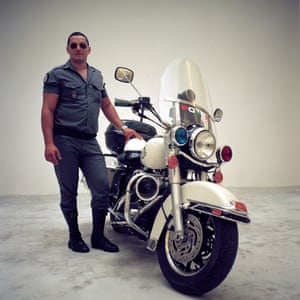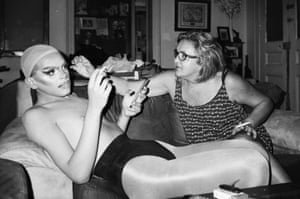[ad_1]
‘Parties are a privileged place, a space for exploration, a time for fusion,” says photographer Cha Gonzalez. They’re also the focus of her series Abandon, which looks at the way some Lebanese people have used nightlife – and techno music in particular – as a release after the trauma of the country’s 15-year civil war, which ended in 1990. “I knew a lot of people who were either born during the war or in exile,” she says. “What was put aside during the day came to light – and their internal struggles surfaced.”
Abandon is a pertinent theme not only for Gonzalez, but for all of the 16 contributors to an exhibition in Paris called C’est Beyrouth (This Is Beirut), at the Institut des Cultures d’Islam. Gonzalez in particular seized on the city’s dance scene, and later continued the series in Paris, where she lives, because “there was something to say about countries that are very far from war as well. The war is inside us: how we feel useless, alone, bored, guilty, horny.”

Photojournalist Hassan Ammar noticed a singular form of expression in Beirut’s Shia community. Ammar had been away from his native country but was back covering ceremonial Ashura – the 10th day of Muḥarram, the first month in the Islamic calendar – when he spotted a man with a shaved and inked head. “In a country like Lebanon, you don’t see people with a face tattoo,” he says.
Over several months, he interviewed men at tattoo parlours as they etched images of Ali (disciple of the prophet Muhammad) and Hassan Nasrallah (the secretary-general of Hezbollah) into their skin. The men told Ammar that tattoos provided a way to express their solidarity with Hezbollah without carrying out extremist behaviour. Of the typical tattooed subject, Ammar says: “He’s not a fighter, he doesn’t hold guns or go to war, but his message is, ‘I’m not afraid.’” Ammar also points out, however, that they “don’t go to pray. Some are partying every night and dating … Their life is the opposite from that of religious people.”

Patrick Baz documented a different kind of self-expression. His series Chrétiens du Liban casts a curious eye on Beirut’s Christian community, clustered on the city outskirts. Baz was a war correspondent for three decades until 2014, when PTSD led him to stop relentless newswire work. After that, he shifted to this series. “I was rediscovering my own country,” he says.
In looking around with fresh eyes, this “very visual” presence and signage of the community stood in sharp contrast to “other communities that do not have such a theatrical approach to their religion”, he says, citing the more discretionary Shias, Sunnis and Druze among the country’s 18 recognised religious sects. The pageantry of iconography – tall crosses piercing the horizon line or the circulation of colossal Jesus statues – he documented are astonishingly cinematic,as if Fellini’s Roma had been transmuted into Middle Eastern set designs.
French-born street photographer Vianney Le Caer’s series also boasts a larger-than-life vibe. He was working for an NGO in Lebanon, and during morning walks by Beirut’s Corniche became riveted by men he saw praying – between working out and tanning. Les Bronzeurs is a striking depiction of masculinity. “There was this element of Islam and nudity that was quite unique,” he says. “These men weren’t like anyone I’d seen before in the Middle East.”

La Caer shot the series in 2015, at the height of the Islamic State’s power, and the fraternising of the Corniche crew provided a startling counterpoint, says Le Caer, to the fact that “two hours away from here, they’re beheading people and all these atrocities are being committed in the name of Islam”.
His series proved somewhat controversial in the exhibition: masculine camaraderie in this state of undress has been interpreted in different ways. “The social codes are quite different there – as friends, brothers,” he says of the regional norms, “but for a western viewer, it has this homoerotic vibe.” (In 2016, the series won second prize at the Amsterdam-based Pride photo award.) The sexual orientation of his subjects is ultimately not his concern – “I really like the ambiguity,” Le Caer says. Although it is typical to see these men at the seaside, some Lebanese viewers were scandalised by the work’s inclusion and thought it was not appropriate to exhibit it.

Ziad Antar’s Policemen series focuses on an easily identifiable trope: the uniform and its role in representing codes of power. He photographed about a dozen police officers alongside their motorcycles, individually, in a studio. “I invited them formally – I went to the police station. They accepted, but I don’t know why,” he says. Antar chose to shoot his subjects at eye level, thwarting the tendency to shoot people in power from below.
“In countries where there are conflicts, there are so many abnormalities with respect to violence and guns and how people respect the laws,” Antar says. “You have different criteria to respect the reality of the country.” Despite being a documentary series, the portraits could almost be from a kitschy TV casting shoot.
Yet Antar is keen to stress that showing a perspective on a region is not a shorthand for understanding a culture. “You’re not showing the Arab world,” he cautions of exhibitions that focus on a particular place. Rather, he says, it’s a way to “show what artists from the Arab world are doing”.
It’s this kind of thinking that motivated Sabyl Ghoussoub, who organised and curated the show, to shake up how Beirut is perceived or imagined, and to assemble the disparate communities he himself weaved between as an outsider (he was born in France but has been based in Beirut for many years). This exhibition provides a visual counterpoint to the headlines-only understanding of a territory, one that can be othering and reductive, and offers a more nuanced understanding of regional complexities.

Indeed, the thematic spectrum of what local artists are exploring is growing more expansive, as exemplified by Mohamad Abdouni’s work. His series Doris & Andrea spotlights a mother and son’s tender quotidian interactions over several weeks. The fact that Andrea is queer is incidental to their relationship.
The series is part of the photographer’s pledge to represent the queer community. Growing up, Abdouni yearned for queer Arab touchstones. “Of course there was western media, which helped a lot, but there was no regional context for it.” That frustration led him to actively document the community. “Queer history is rich, but it’s [preserved] through word-of-mouth stories you hear from older members. It’s never something written down, photographed, filmed. I want to leave a trace.” In 2017, he started Cold Cuts, a photo-journal about queer Arab culture; two new issues are in the works for 2019.
Abdouni is invested in chronicling not only the queer scene’s existence, but also its increasing wilfulness. “The community is less and less afraid. The law hasn’t changed – homosexuality is still illegal, crossdressing, regardless of sexual orientation, is still illegal – but we’re just more courageous, fed up. There’s a desire for expression, a desire for conversation, a desire for change.” He was delighted that this series is shown at an Islamic centre: it’s a powerful symbolic context. But while Abdouni has had a successful fashion photography career with global reach, working on fashion campaigns for Fendi and Gucci among others, his independent queer-focused projects have not yet been shown in his own city. “Attention is gathering from outside,” he says of the enthusiasm for Doris & Andrea. “But I don’t think the work that I do is as important anywhere in the world as it is at home.”
• C’est Beyrouth is at Institut des Cultures d’Islam, Paris, until 28 July.
[ad_2]
READ SOURCE


